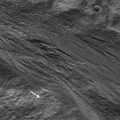
WIKIARCHIVES.SPACE
The Human Spaceflight Archive

A plethora of boulders surrounds braided flows of impact melt along the inside wall of crater Epigenes A. As the melt moves toward the crater floor (direction indicated by white arrow), the flow buries and moves boulders. Epigenes A is a 18 km diameter crater located at 66.9°N and 0.3°W on the rim of crater W. Bond. The NAC image is 540 meters wide.
Information
- Taken in
- Author
- NASA/GSFC/Arizona State University
- Description
-
A plethora of boulders surrounds braided flows of impact melt along the inside wall of crater Epigenes A. As the melt moves toward the crater floor (direction indicated by white arrow), the flow buries and moves boulders. Epigenes A is a 18 km diameter crater located at 66.9°N and 0.3°W on the rim of crater W. Bond. The NAC image is 540 meters wide.
Within the Crater Epigenes A there is a remarkable variety of impact melt features. Impact melt is common and occurs when energy released by an impact causes rocks and regolith in the target to melt. Impact melts form small particles, known as impact melt spherules, or large, smooth pools and sheets of melt that coalesce in low areas within the crater. While the material is molten it behaves like lava, flowing down-slope. Emplacement of the melt is thought to occur during the excavation and modification stages of crater formation. An outward surge of impact melt (possibly caused by the collapse of the central uplift) falls on the rim, wall, and ejecta blanket of the impact crater and then gravity pulls the melt downward during the modification stage of the impact crater's formation.
NASA's Goddard Space Flight Center built and manages the mission for the Exploration Systems Mission Directorate at NASA Headquarters in Washington. The Lunar Reconnaissance Orbiter Camera was designed to acquire data for landing site certification and to conduct polar illumination studies and global mapping. Operated by Arizona State University, the LROC facility is part of the School of Earth and Space Exploration (SESE). LROC consists of a pair of narrow-angle cameras (NAC) and a single wide-angle camera (WAC). The mission is expected to return over 70 terabytes of image data.
- Created on
- Friday 23 October 2009
- Albums
- US SPACE PROGRAM / PROBES / MOON / LRO/LCROSS / Mission Photos (Edited)
- Source link
- https://photojournal.jpl.nasa.gov
- Visits
- 19
- Rating score
- no rate
- Rate this photo
- License
- Public Domain
- Modified by WikiArchives
- No (original)
- Downloads
- 0
Powered by Piwigo
